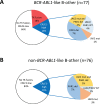Tyrosine kinase fusion genes in pediatric BCR-ABL1-like acute lymphoblastic leukemia
- PMID: 27894077
- PMCID: PMC5354859
- DOI: 10.18632/oncotarget.13492
Tyrosine kinase fusion genes in pediatric BCR-ABL1-like acute lymphoblastic leukemia
Abstract
Approximately 15% of pediatric B cell precursor acute lymphoblastic leukemia (BCP-ALL) is characterized by gene expression similar to that of BCR-ABL1-positive disease and unfavorable prognosis. This BCR-ABL1-like subtype shows a high frequency of B-cell development gene aberrations and tyrosine kinase-activating lesions. To evaluate the clinical significance of tyrosine kinase gene fusions in children with BCP-ALL, we studied the frequency of recently identified tyrosine kinase fusions, associated genetic features, and prognosis in a representative Dutch/German cohort. We identified 14 tyrosine kinase fusions among 77 BCR-ABL1-like cases (18%) and none among 76 non-BCR-ABL1-like B-other cases. Novel exon fusions were identified for RCSD1-ABL2 and TERF2-JAK2. JAK2 mutation was mutually exclusive with tyrosine kinase fusions and only occurred in cases with high CRLF2 expression. The non/late response rate and levels of minimal residual disease in the fusion-positive BCR-ABL1-like group were higher than in the non-BCR-ABL1-like B-others (p<0.01), and also higher, albeit not statistically significant, compared with the fusion-negative BCR-ABL1-like group. The 8-year cumulative incidence of relapse in the fusion-positive BCR-ABL1-like group (35%) was comparable with that in the fusion-negative BCR-ABL1-like group (35%), and worse than in the non-BCR-ABL1-like B-other group (17%, p=0.07). IKZF1 deletions, predominantly other than the dominant-negative isoform and full deletion, co-occurred with tyrosine kinase fusions. This study shows that tyrosine kinase fusion-positive cases are a high-risk subtype of BCP-ALL, which warrants further studies with specific kinase inhibitors to improve outcome.
Keywords: BCR-ABL1-like; minimal residual disease; pediatric B cell precursor acute lymphoblastic leukemia; tyrosine kinase fusion.
Conflict of interest statement
The authors declare no conflicts of interest.
Figures


References
-
- Biondi A, Schrappe M, De Lorenzo P, Castor A, Lucchini G, Gandemer V, Pieters R, Stary J, Escherich G, Campbell M, Li CK, Vora A, Arico M, et al. Imatinib after induction for treatment of children and adolescents with Philadelphia-chromosome-positive acute lymphoblastic leukaemia (EsPhALL): a randomised, open-label, intergroup study. Lancet Oncol. 2012;13:936–945. - PMC - PubMed
-
- Schultz KR, Carroll A, Heerema NA, Bowman WP, Aledo A, Slayton WB, Sather H, Devidas M, Zheng HW, Davies SM, Gaynon PS, Trigg M, Rutledge R, et al. Long-term follow-up of imatinib in pediatric Philadelphia chromosome-positive acute lymphoblastic leukemia: Children's Oncology Group study AALL0031. Leukemia. 2014;28:1467–1471. - PMC - PubMed
-
- Den Boer ML, van Slegtenhorst M, De Menezes RX, Cheok MH, Buijs-Gladdines JG, Peters ST, Van Zutven LJ, Beverloo HB, Van der Spek PJ, Escherich G, Horstmann MA, Janka-Schaub GE, Kamps WA, et al. A subtype of childhood acute lymphoblastic leukaemia with poor treatment outcome: a genome-wide classification study. Lancet Oncol. 2009;10:125–134. - PMC - PubMed
-
- Van der Veer A, Waanders E, Pieters R, Willemse ME, Van Reijmersdal SV, Russel LJ, Harrison CJ, Evans WE, Van der Velden VHJ, Hoogerbrugge PM, Van Leeuwen F, Escherich G, Horstmann MA, et al. Independent prognostic value of BCR-ABL1-like signature and IKZF1 deletion, but not high CRLF2 expression, in children with B-cell precursor ALL. Blood. 2013;122:2622–2629. - PMC - PubMed
MeSH terms
Substances
LinkOut - more resources
Full Text Sources
Other Literature Sources
Molecular Biology Databases
Research Materials
Miscellaneous

